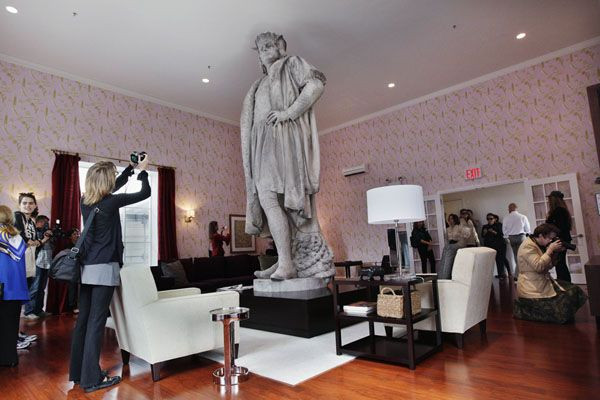Despite Critics, Columbus Circle Art Installation Is A Hot Ticket

Imagine coming face to face with Christopher Columbus on Columbus Day.
On Monday, a select few visitors to New York’s Columbus Circle will get up close and personal with a famous likeness of the Italian explorer, thanks to the popular art installation “Discovering Columbus.”
The free installation -- conceived by the Japanese conceptual artist Tatzu Nishi -- has become New York’s hottest ticket this fall. Since it opened on Sept. 20, about 20,000 visitors have already made the trek up six flights of stairs for a close-up view of Gaetano Russo’s famous marble statue, which is enclosed by a mock living room that sits on a tower of scaffolding some 75 feet in the air.
The top of the Columbus statue rises out of a coffee table in the middle of the makeshift living room, which comes complete with pink wallpaper -- designed by Nishi -- featuring images of American pop-culture figures such as Elvis Presley, Marilyn Monroe and Martin Luther King Jr.
Tickets are already booked up for Columbus Day, but the free installation is open until Nov. 18. Organizers expect to see another 80,000 visitors before then, according to New York’s Public Art Fund, which is presenting the installation.
Sponsors for the project include Bloomberg LP and Time Warner Inc. (NYSE: TWX), which owns the Time Warner Center on Columbus Circle’s west side.
Nishi is known for transforming monuments into temporary living spaces, having previously created functioning hotels around a statue of Queen Victoria for the Liverpool Biennial and another around Singapore’s Merlion fountain. “Discovering Columbus” is the artist’s first installation in the United States.
Not everyone is happy with the art project, however. At least one Italian-American group has been a vocal opponent of the installation, saying it belittles the famous explorer and his accomplishments. “Encasing this majestic statue in a cocoon of conceptual art demeans the community and trivializes history,” Rosario Iaconis, chairman of the Italic Institute of America, told AP in August, before the project opened.
John Mancini, the institute’s executive director, told the New York Post that the project is in “bad taste.” He reiterated that feeling in an AP story on Monday, saying that Nishi had hijacked Russo’s original statue, turning it into a “stage prop.”
Russo’s 13-foot marble statue, which sits atop a 60-foot granite column, was first unveiled in 1892 to commemorate the 400th anniversary of Columbus’s first voyage to the Americas. Over time, the monument has been badly damaged and worn down by the elements. Concurrent with the installation, a $1 million conservation effort is also under way in cooperation with the city’s Department of Parks and Recreation. The upkeep includes stone repair and cleaning of the granite and marble features, as well as a bronze surface treatment.
Visitors wishing to get free passes to “Discovering Columbus” can visit the Public Art Fund’s website. As of Monday, tickets were almost completely sold out through Oct. 14.
© Copyright IBTimes 2025. All rights reserved.






















